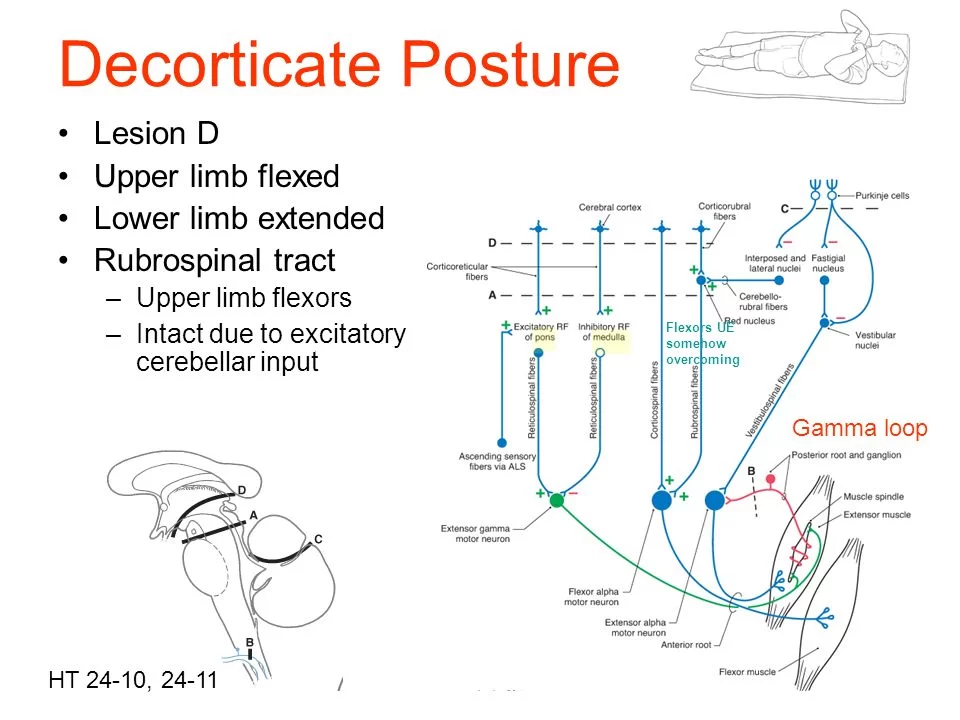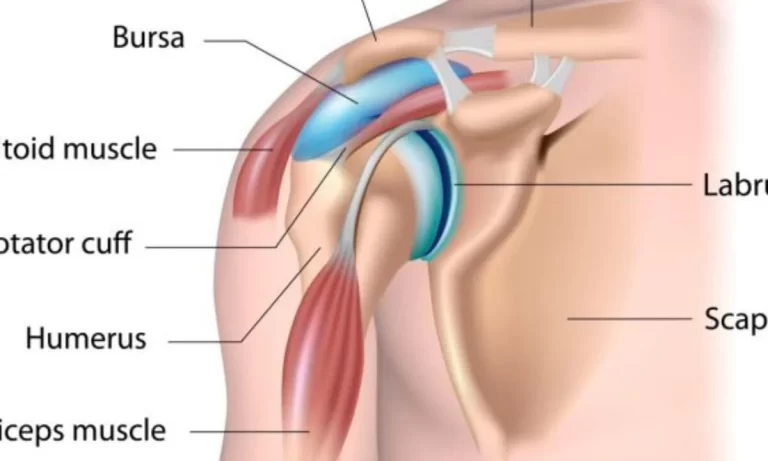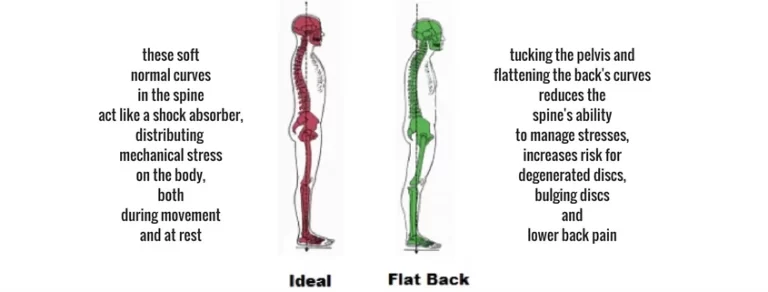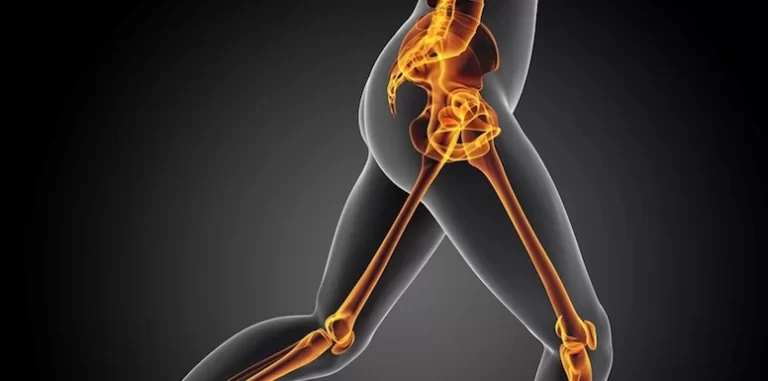Decorticate Posture
Introduction:
Decorticate posture — a sign of severe damage to the brain — is an abnormal posturing in which a person is stiff with bent arms, clenched fists, and legs held out straight. The arms are bent in toward the body and the wrists and fingers are bent and held on the chest. This type of posturing is a sign of severe damage in the brain.

Decorticate posturing is a type of abnormal or pathologic posturing, not to be mistaken with poor posture or slouching. Abnormal posturing is often an indication of certain types of injury to the brain or spinal cord.
Decorticate posturing is also called decorticate response, decorticate rigidity, flexor posturing, or, colloquially, mummy baby.
Patients with decorticate posturing present with the arms flexed, or bent inward on the chest, the hands are clenched into fists, and the legs extended and feet turned inward. A person displaying decorticate posturing in response to pain gets a score of three in the motor section of the Glasgow Coma Scale, due to the flexion of muscles due to the neuro-muscular response to the trauma.
There are two parts to decorticate posturing.
- The first is the disinhibition of the red nucleus with facilitation of the rubrospinal tract. The rubrospinal tract facilitates motor neurons in the cervical spinal cord supplying the flexor muscles of the upper extremities. The rubrospinal tract and medullary reticulospinal tract biased flexion outweighs the medial and lateral vestibulospinal and pontine reticulospinal tract biased extension in the upper extremities.
- The second component of decorticate posturing is the disruption of the lateral corticospinal tract which facilitates motor neurons in the lower spinal cord supplying flexor muscles of the lower extremities. Since the corticospinal tract is interrupted, the pontine reticulospinal and the medial and lateral vestibulospinal biased extension tracts greatly overwhelm the medullary reticulospinal biased flexion tract.

The effects on these two tracts (corticospinal and rubrospinal) by lesions above the red nucleus is what leads to the characteristic flexion posturing of the upper extremities and extensor posturing of the lower extremities.
Decorticate posturing indicates that there may be damage to areas including the cerebral hemispheres, the internal capsule, and the thalamus. It may also indicate damage to the midbrain. While decorticate posturing is still an ominous sign of severe brain damage, decerebrate posturing is usually indicative of more severe damage at the rubrospinal tract, and hence, the red nucleus is also involved, indicating a lesion lower in the brainstem.

Causes of decorticate posturing :
Decorticate posture can be caused by a number of conditions, including:
- Traumatic brain injury (TBI).
- Bleeding in the brain.
- Brain tumor.
- Stroke.
- Brain problems due to drug use, poisoning, infection, or liver failure.
- Increased pressure in the brain.
- Infection, such as Reye’s syndrome, malaria, or encephalitis.
When to see a doctor about decorticate posturing
Abnormal posturing is a condition that should be examined and treated right away by a doctor. A person with decorticate posturing will be unconscious, often in a coma. In many cases, the doctor will set up breathing assistance for the person and admit them into the hospital’s intensive care unit (ICU).
A thorough examination of the brain and nervous system typically follows and may include some or all of the following:
- CT scan or MRI of the head
- EEG
- Cerebral angiography
- Lumbar puncture
Treatment
The decorticate posturing is a symptom, not a disease. So the disease that’s causing it, though, might be treatable.
There are additional potential sorts of care that a person with decorticate posture may require in addition to treating the underlying condition. Those who have this sensation are likely to be unconscious or in a coma position and may require extra supportive care. Mechanical ventilation, which aids with breathing, is an illustration of supportive care.
The therapy options can differ because there are so many potential causes of decorticate posturing. The best person to inform you of treatment options and the ones they suggest is a healthcare professional.
What are the possible complications if not treated decorticate posturing?
Decorticate posture is typically a symptom of significant brain injury or abnormalities in brain function. Without treatment or delay in treatment, many of the disorders that cause it are fatal.
Permanent harm may also be caused by therapeutic delays. When permanent damage occurs, the previously controlled skills by the affected parts may be significantly compromised or lost forever.
Decorticate posturing Prognosis:
The expected outcome depends on the cause. Decorticate posturing could indicate nervous system injury and permanent brain damage, which could result in:
- seizures
- paralysis
- inability to communicate
- coma
Summary
Those who have to decorticate posturing are coma-like and unconscious. This symptom is a crucial sign of illnesses that harm the brain or impair its functions.
This symptom does not, however, imply that there is no chance of survival or recovery. Many neurological problems that might result in decorticate posturing can now be treated because of modern medical advancements. There is hope for many people who are now experiencing decorticate posturing as the prognosis is constantly improving.
FAQs
What does decorticate posturing indicate?
A person who is stiff, with bent arms, clenched fists, and legs held out straight, is said to be in decorticate posture. The fingers and wrists are held on the chest while the arms are bowed inward towards the torso. Posturing in this way indicates significant brain injury.
Why is Decorticate better than decerebrate?
Injury to the cerebral cortex, particularly if it entails injury to the internal capsules, results in decorticate posturing. Decorticate posturing is more common than decerebrate posturing but often has higher survival rates.
What causes Decorticate positioning?
Causes of decorticate posturing are
A brain-related condition such as brain cancer, stroke, drug usage, poisoning, infection, liver failure, and other related brain issue leads to Decorticate positioning.








This was more than helpful, it was great. Ive had a better understanding about both decerebration and decortication and I’m ready for my presentation .